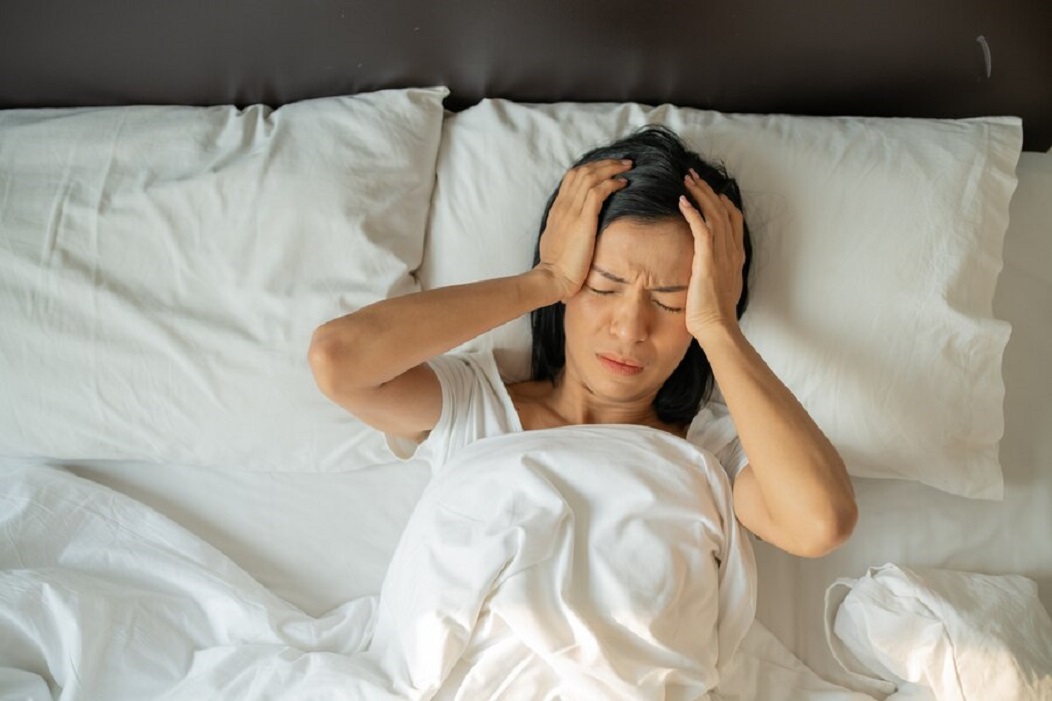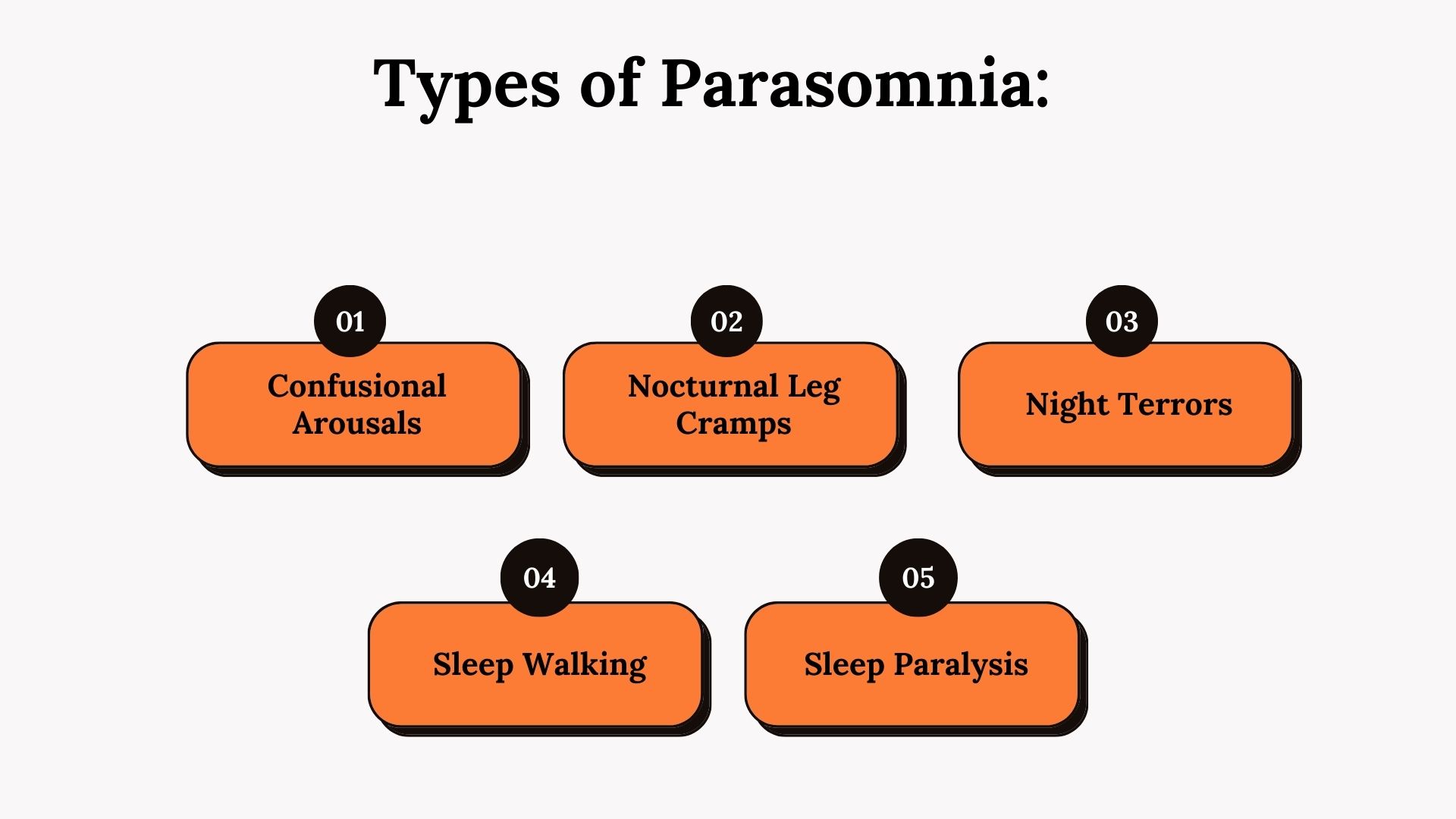Parasomnia is a disruptive sleep-related disorder that involves certain abnormal behaviors during sleep, such as purposeless or repetitive movements, walking, talking, and unusual or undesirable actions.
These factors disrupt normal sleeping patterns and happen while you are asleep, although your bed partner might think that you are awake or aware of your condition.
This sleep-related disorder can be categorized as primary Parasomnia (disorders of sleep states) and secondary Parasomnia (disorders of other organ systems that may manifest during sleep, including respiratory dyskinesia, seizures, or gastroesophageal reflux).
Examples of parasomnia usually include:
- Sleep terrors
- Sleepwalking
- Nightmare disorders
- Eating disorder
- Sleep paralysis
Parasomnia disorder is most common among children with certain psychiatric or neurological conditions, such as ADHD or epilepsy.
Causes like sleep deprivation, trauma, and stress can also trigger parasomnia in children. However, child parasomnia usually occurs because of disturbed or immature sleep-wake cycles.
Types of Parasomnia:
-
Confusional Arousals
Confusional arousals usually occur when a person wakes from a deep sleep during the first part of the night. This sleep-related disorder makes people very slow when they wake up, and they react slowly to commands and might have trouble understanding when someone asks them about anything.
People suffering from this disorder usually do not remember the event the next day.
-
Nocturnal Leg Cramps
Nocturnal leg cramps are painful, involuntary, and sudden muscle spasms or contractions during rest. They usually happen in the calves’ muscles.
This painful cramping feeling can last from a few seconds to a few minutes, but the pain may linger. The actual cause of leg cramps is still unknown, but it is sometimes associated with certain sleep-related disorders, such as Parasomnia.
-
Night Terrors
Night terrors, also referred to as sleep terrors, are episodes of confusion, fear, and screaming while a person is asleep.
Night terrors are usually experienced by children. Toddlers experiencing night terrors usually try to walk or crawl in their sleep; that’s why they need to be watched so that they do not hurt themselves.
Night terrors can last a few seconds to a few minutes and often take place with sleepwalking. Unlike nightmares, a person experiencing a night terror generally does not remember anything the following day.
In children, night terrors are rarely caused by a mental or physical illness and are more common in people with sleep problems, such as Parasomnia or obstructive sleep apnea.
-
Sleep Walking
Sleepwalking also called somnambulism, is a disorder in which a person walks around in the house while being partially asleep during the night and does not realize it.
The sleepwalker might make unconscious repetitive movements, such as fumbling with clothing, getting out of bed and strolling around, or even talking unconsciously.
Sleepwalking is a type of sleep disorder that is not a cause for concern, and most children can outgrow this condition during their teenage years.
-
Sleep Paralysis
Sleep paralysis is a type of sleep-related disorder in which a person becomes unable to move his muscles as he wakes up or falls asleep. This usually happens because a person is in sleep mode, but his brain is active.
The actual cause of sleep paralysis is still unknown but is sometimes linked with insomnia. The episode of this disorder usually subsides on its own.
It can also end when someone touches or speaks to the person suffering from it. Making an intense effort to move can also end this episode.
Treatments For Parasomnia
Treatments for this sleep disorder mainly depend on the severity and type of condition. However, the doctor might recommend the following treatments for the patients suffering from this disorder:
-
Medication
If your Parasomnia occurs frequently or in a recurring manner, medications can help manage it. However, the choice of certain medicines usually depends on the extent of the patient’s symptoms.
Common examples of medications that are used to treat parasomnias typically include antidepressants, dopamine agonists, melatonin, etc.
On the other hand, if symptoms persist due to a certain medication, the doctor may recommend an alternative medication or a different dose. However, patients should not stop taking medications without their doctor’s consultation.
-
Cognitive Behavioural Therapy
Cognitive behavioral therapy (CBT) is a common treatment for sleep-related disorders, specifically Parasomnia. That’s because Parasomnia is often interlinked with mental health problems like anxiety or stress.
Other methods might also be used alongside cognitive behavioral therapy, including:
- Psychotherapy.
- Relaxation therapy.
- Hypnosis.
-
Home Treatments
Some treatments for sleep disorders, suggested by the doctor, can also be carried out at home, which includes scheduled awakenings. In this treatment, people are supposed to be woken up by someone 15 to 30 minutes before they spontaneously wake up.
It may help treat certain behaviors that follow a particular pattern. This method is often used for night terrors and sleepwalking. Moreover, safer sleep environments can also help minimize the risks of various sleep disorders.
Many people who suffer from Parasomnias can see a significant improvement in their symptoms simply by improving their sleep habits. Good sleep habits usually allow a person to have a relaxing bedtime routine, keep a regular sleep schedule, manage stress, and get enough sleep.
FAQs
How Do You Fix Parasomnia?
We can fix Parasomnia by improving our sleep habits, we should manage our sleep time to fix it.
How Long Does Parasomnia Last For?
It can last for 30 to 40 minutes, but its time period can short also from this.
How Serious Is Parasomnia?
It can be serious in some conditions when the person harms himself or others unknowingly.



